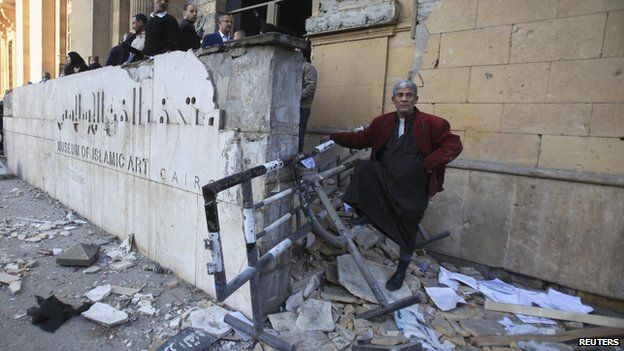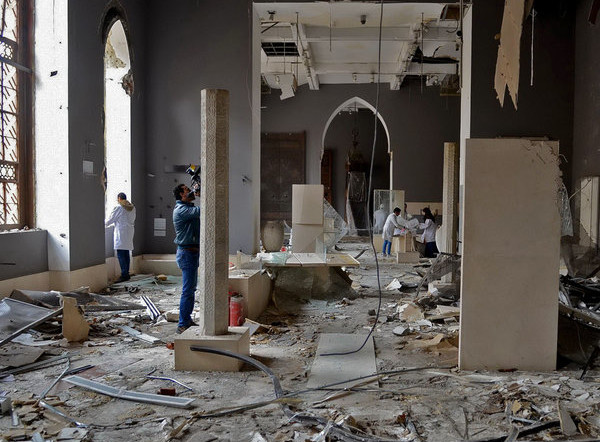Abdel Hamid Salah el-Sharief arrived at the Museum of Islamic Art in Cairo, Egypt to confront a glittering sea of broken glass. Past the smashed wooden doors and the acrid haze of smoke, the remains of the museum’s extravagant windows lay broken into countless pieces on the floor. What once offered a glimpse into the world of Islam’s Golden Age, and accentuated some of the museum’s most prized collections, now illuminated nothing but the bomb’s extensive carnage: 15th-century glass lamps shattered, hundreds of ceramic artifacts disintegrated – an interior peppered with debris.
“It was horrible,” el-Sharief recalls.
A conservator at the Egyptian Ministry of Antiquities and the co-founder of the Egyptian Heritage Rescue Team, el-Sharief was one of the first to assess the carnage. On that quiet Friday morning in late January 2014, militants detonated a car bomb in front of the Cairo police headquarters. Contorted metal shrapnel and concrete ripped through the square and its surrounding buildings, injuring 90, killing six, and leaving the nearby museum’s elaborate facade wounded by bowling-ball-sized craters. The destruction of the outer walls was incomparable to what happened inside: 74 artifacts were completely destroyed, and another 90 suffered grievous damage.
“The Museum [of Islamic Art] is the most important museum for Islamic art in the world. The Egyptian National Library and Archives [on the top floor] housed microfilms, regional books from medieval times, and other irreplaceable objects. Their combined value is… incalculable.”
After working on the front lines of cultural preservation in Egypt for several years, el-Sharief was ready. “We had a trained team there one hour after the bomb blast went off,” he says. In contact with a network of officials throughout the government, ministries, and police, he was able to get to work immediately: “My team and I assessed the damage, and we made a plan.”
Upon arrival, they divided into four sub-groups and fanned throughout the museum, cataloguing and preparing the items based on importance and extent of damage. “We worked from 9 a.m. to 8 p.m., and we rescued 576 objects with full documentation. We packed and gave them new location numbers for storage. We finished the assignment in one day, and the total work took one day and a half” he explained.
The thoroughness of his work was instrumental in saving the antiquities from further harm, but also in ensuring that they could be identified and retrieved. “Our colleagues from the museum were able to find everything after we left, because we had documented everything: where it was, how it was stored, its state of damage. Through this, we were able to save a lot of objects at the end of the day.”

The entrance to the Museum, after the bomb blast
El-Sharief’s swift, competent response to the crisis represents a growing trend within Egyptian conservation, but it wasn’t always this way. For a long time, he says, “we didn’t know what to do in these emergency situations,” and he laughs when he remembers the extent of his old job: “My specialty was co-creating natural finishing for wood and stone based on old materials. When these crises began, we knew nothing about them, and we really messed up.”
Case in point: in March 2011, el-Sharief received word that a cache of antiquities would be looted. “My colleagues and I went to rescue [them], but we didn’t do any kind of documentation. We didn’t know what we had moved or how many objects. That’s when we realized that most of them had been stolen, because we didn’t do proper documentation. [Now], we can’t even prove that they belong to Egypt under the antiquities law. These were 5,000-year-old artifacts. They’re lost forever.”
He resolved to never let such a blunder happen again, and he dove directly into the field of rapid heritage preservation with a course in Rome in 2011. Gaining a background in best practices and methods to preserve items quickly and accurately, he was quick to share his knowledge. “After the course in Rome, I qualified to be part of the Egyptian Heritage Rescue team, and after our success, I went to Iraq, Kurdistan, and Tunisia to train others. We also organized a regional workshop, training six participants from six countries in the region: Libya, Sudan, Syria, Egypt, Palestine, Iraq.”
Now with nearly five years of experience behind him, el-Sharief is an expert in his own right. “I think that RIA (Rapid Impact Assessment) should come within the first few days of the emergency according to the level [of the emergency]. It allows you to find out where you stand, and where you start.” Though a necessity in all emergency situations, this is especially important for countries that have limited conservation resources, such as Nepal. “When [they have] a disaster, they have limited money and people and don’t know where they should start. But if the local people have the ability to assess the situation, they can make a priority list and begin to rebuild”
Global Heritage Fund has begun to fill this need with its AMAL in Heritage program. A technical support application, AMAL provides heritage professionals with assistance in preparedness, response, and recovery with a combination of distance learning, mobile impact assessment tools, and technical support applications. AMAL, conceptualized and initiated with the support of the Netherlands-based Prince Claus Fund, is designed for documenting cultural assets and assessing damage to cultural heritage during high-risk, emergency situations.
An early participant in Global Heritage Fund’s AMAL in Heritage program, el Sharief is convinced it is a necessary tool for today’s conservation landscape. “I think it is very useful, logical, simple, and scientific. Imagine yourself not in an emergency situation, but in an exam. What is the most useful thing to you now? Not a book, but smart advice on how to answer a question. I think this application is important for when you know nothing, for when you have a minute and you have a question and can find an answer. You are in the dark, but you have found the light. This is my idea about AMAL. AMAL is very useful in that way, because it provides this assistance on demand, when it’s needed. Not when it might be convenient.”

Shattered glass in the Museum of Islamic Art, Cairo
El-Sharief, just one man amidst an already small group of conservators, feels what can best be described as resolute helplessness. “Conservation is like… a drowning man clutching at straws,” he states. “But that is no reason to give up. I am still going to Libya, because no one is supporting them there. You cannot train everyone, and we will never know where the [next] emergency will happen. But we can help people prepare.”
El-Sharief’s attitude is admirable in a country faced with countless ongoing challenges. Since 2011, antiquities have been illegally sold or poorly treated, archaeological sites have been illicitly uncovered, and Egyptian officialdom has become a viper’s den of corruption from the top to the bottom. Left ill equipped and ill prepared for the wave of crises that would follow the protests in Tahrir Square, the nation’s conservators could do nothing but watch in horror as the revolution metastasized and the museums, monuments, and other testaments to their millennia-old heritage went up in flames:
- Many historic villas, built by Egypt’s bourgeoning middle class in the 19th and 20th centuries, have been razed.
- The sites of Fustat, al-Matariyyah, Dahshour, and Muhammad Ali’s Shubra Palace, among others, have seen unauthorized development, looting, damage, or all of the above.
- The Malawi National Museum in Minya was completely ransacked and looted in 2013, with only 48 objects remaining.
- The cultural heritage of Cairo – unprotected because unfunded – is being slowly bled away by the demands of a booming antiquities market
Even el-Sharief’s once green, now seasoned Egyptian Heritage Rescue Foundation cannot save everything. He relates “in 2012, an institute in Egypt had a masterpiece collection of maps and books, but this was burned due to the sequence of events in the revolution. It was in the middle of a big fight between the police, army, and the people, so we couldn’t intervene due to the violence.”
The problems go beyond navigating violence between conflicting factions, however: there is little will, either institutionally or popularly, to conserve cultural heritage. “If something is not safe, we need to move it to another safe location. But to convince people that these things require documentation and other critical work, this is the challenge. After the training, we learned what to do. We learned from our mistakes and learned we had to have a methodology and adapt it to the situation while keeping the main concepts of this knowledge intact. But it is very hard to fight [for these things] when there is no desire. That’s a big reason I think AMAL is important. It’s providing the tools, the training, and the help that had been absent before.”
When asked what he believes is missing from the conservation sphere, he grows silent for a moment of reflection. Then he says: “It’s about creating a need for people, a desire. My work? You do it because you like it, you do it because you love it, because your goal in life is to protect it. You attend courses because you care, because you have a passion, because you want to go directly on a mission. Syrian, Russian, Nepali, Egyptian. It doesn’t matter. You go because you care. It’s not about going to work in the morning, leaving in the afternoon, and staying with family in the evening. With this work, if I die now, I die after having done something meaningful.”

